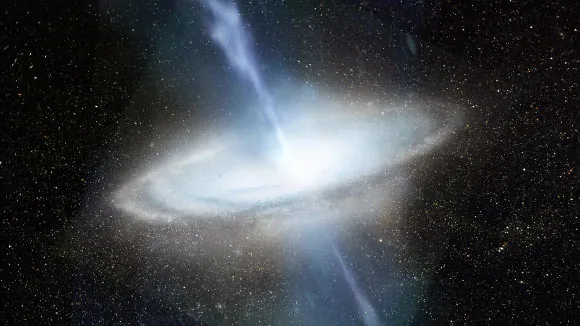
Astronomers Discover Magnetic Structures in Messier 77's Accretion Disk: What it Means for Our Understanding of Black Holes
2024-12-11
Author: Wei Ling
Introduction
In a groundbreaking study, astronomers have observed intricate magnetic filaments in the accretion disk surrounding the supermassive black hole of Messier 77, also known as NGC 1068. This luminous barred spiral galaxy, located 62 million light-years away in the constellation of Cetus, is renowned not just for its beauty but also for its comparatively close proximity to Earth, making it a prime candidate for detailed astronomical investigations.
Historical Background
First discovered by French astronomer Pierre Méchain in 1780, Messier 77 was initially misidentified as a nebula. Over time, as astronomical technology advanced, it became clear that this majestic structure is, in fact, a galaxy that spans around 100,000 light-years across and is one of the largest in the Messier catalog. Its immense gravitational influence even causes neighboring galaxies to warp and twist, a phenomenon visible in the local cosmic neighborhood.
Challenges in Observation
Despite the galaxy’s relative brightness, with an apparent magnitude of 9.6, its central region is often obscured by dense clouds of dust and gas. This veil has made it challenging for astronomers to study the accretion disk—a swirling ring of material feeding the supermassive black hole—until recent advancements in radio astronomy.
Research Methodology
Astronomer Jack Gallimore from Bucknell University, along with his colleagues, utilized the upgraded High Sensitivity Array (HSA) to investigate Messier 77's water masers—natural amplifiers of microwave radiation. By focusing on the polarization of these masers, the team succeeded in mapping complex structures that hint at the presence of magnetic fields within the galaxy.
Significance of Findings
Dr. C.M. Violette Impellizzeri from Leiden Observatory, part of the research team, emphasized Messier 77's significance in active galactic studies, describing it as a “VIP among active galaxies.” The galaxy's unique orientation and powerful black hole provide a rare opportunity for in-depth analysis.
New Discoveries
In what can only be described as a cosmic revelation, the researchers found that the water masers form distinct filamentary structures resembling "beads on a string." Surprisingly, they also observed a dislocation between the radio emissions from the core and the position of the masers, suggesting our view of the galaxy’s structure is far more complex than previously thought.
Implications for Magnetic Fields
These findings indicate that the region is likely influenced by magnetic fields, marking the first time astronomers have detected polarized water masers outside our own Milky Way galaxy. This discovery aligns with patterns seen in solar prominences, suggesting that magnetic forces are an essential driver of these phenomena.
Further Research Opportunities
The research also revealed intriguing features within the radio continuum, including a mysterious protrusion nicknamed the "foxtail," which stretches from the central region—a potential hint that more secrets lie hidden in Messier 77's depths.
Conclusion
Dr. Gallimore expressed excitement about the study's outcomes, noting that both continuum and polarization data exceeded their expectations, paving the way for future research that could unravel even more mysteries about the dynamics of active galaxies and the role of magnetic fields in cosmic evolution.
Publication
The research findings, published in the *Astrophysical Journal Letters*, are poised to enhance our understanding of the behavior of black holes and their surrounding environments, offering new insights into the complex interplay between gravitational forces and electromagnetic phenomena in the universe. As more data comes to light, astronomers may soon unlock even more secrets of the cosmos hidden within galaxies like Messier 77.


 Brasil (PT)
Brasil (PT)
 Canada (EN)
Canada (EN)
 Chile (ES)
Chile (ES)
 España (ES)
España (ES)
 France (FR)
France (FR)
 Hong Kong (EN)
Hong Kong (EN)
 Italia (IT)
Italia (IT)
 日本 (JA)
日本 (JA)
 Magyarország (HU)
Magyarország (HU)
 Norge (NO)
Norge (NO)
 Polska (PL)
Polska (PL)
 Schweiz (DE)
Schweiz (DE)
 Singapore (EN)
Singapore (EN)
 Sverige (SV)
Sverige (SV)
 Suomi (FI)
Suomi (FI)
 Türkiye (TR)
Türkiye (TR)